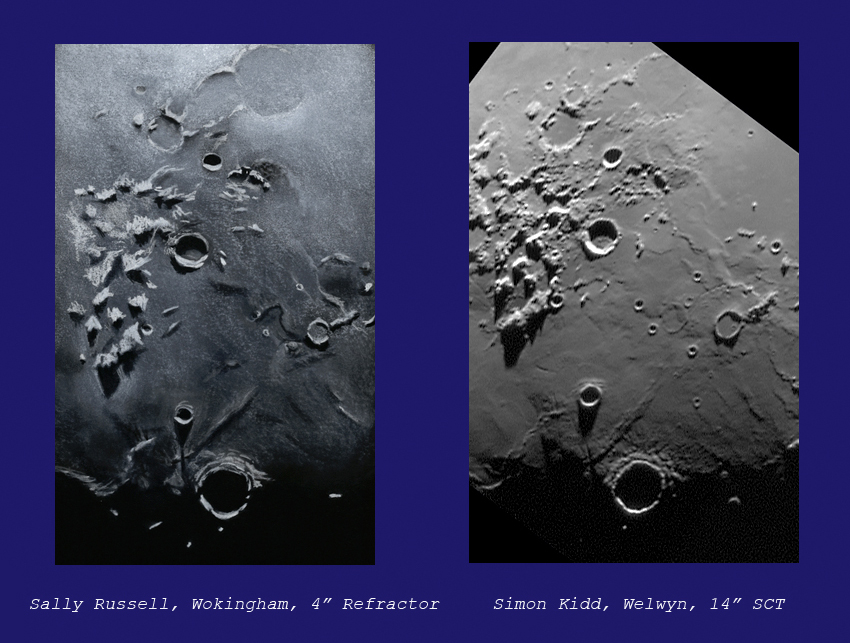|
|
| (7 intermediate revisions by the same user not shown) |
| Line 1: |
Line 1: |
| | __NOTOC__ | | __NOTOC__ |
| | =Old & New= | | =Old & New= |
| | + | <!-- Start of content --> |
| | + | <div class="post" id="post-1107"> |
| | | | |
| − |
| + | <div class="storycontent"> |
| − | <div class="post" id="post-1107">
| + | <p>[[File:Plinius__Vitruvius__Jansen.jpg|Plinius__Vitruvius__Jansen.jpg]]<br /> |
| − |
| |
| − | <div class="storycontent">
| |
| − | <p>[[File:Plinius__Vitruvius__Jansen.jpg|Plinius__Vitruvius__Jansen.jpg]]<br />
| |
| | <em>sketch by [mailto:art.and.astronomy@googlemail.com Sally Russell] and image by [mailto:as.kidd@tiscali.co.uk Simon Kidd], both in UK.</em></p> | | <em>sketch by [mailto:art.and.astronomy@googlemail.com Sally Russell] and image by [mailto:as.kidd@tiscali.co.uk Simon Kidd], both in UK.</em></p> |
| | <p>For four hundred years observers documented the Moon with drawings. And for the last 150 years photographs were also used to capture lunar detail. For nearly all of this time the artists could typically see smaller features in instants of steady seeing than cameras could record in their integrated exposures. Now in the last decade the invention of webcams and the selecting and stacking of hundreds of short exposure images finally doomed visual observing. What we have lost and gained are illustrated here with these independent but simultaneous depictions of the area near Plinius. Sally, an experienced observer and skilled artist, captured the essence, the feeling of this area, and Simon captured the reality. Of course, differences can not be ascribed just to differences in recording techniques since vastly different apertures were used. But there are many differences of detail. The drawing is focused on the center of the sketch, from the glacis around Plinius to the ridges in northern Mare Tranquillitatis (north to the left). The areas around the edges of the sketch are just roughed in, lacking detail that would have been seen if they had been the center of attention. And even the features near the center of the sketch are somewhat abstract, showing form more than detail. For example, the prominent small crater just north of Jansen is shown on the sketch, but not as a recognizable crater. If Sally’s drawing had been made 150 years ago, and the next observer’s drawing showed the crater, there would be excitement over the discovery of a new formation… For studies of the lunar surface Simon’s image is ideal, but for framing and hanging on the wall of my study I’d want Sally’s evocative sketch. We have the luxury of having both!</p> | | <p>For four hundred years observers documented the Moon with drawings. And for the last 150 years photographs were also used to capture lunar detail. For nearly all of this time the artists could typically see smaller features in instants of steady seeing than cameras could record in their integrated exposures. Now in the last decade the invention of webcams and the selecting and stacking of hundreds of short exposure images finally doomed visual observing. What we have lost and gained are illustrated here with these independent but simultaneous depictions of the area near Plinius. Sally, an experienced observer and skilled artist, captured the essence, the feeling of this area, and Simon captured the reality. Of course, differences can not be ascribed just to differences in recording techniques since vastly different apertures were used. But there are many differences of detail. The drawing is focused on the center of the sketch, from the glacis around Plinius to the ridges in northern Mare Tranquillitatis (north to the left). The areas around the edges of the sketch are just roughed in, lacking detail that would have been seen if they had been the center of attention. And even the features near the center of the sketch are somewhat abstract, showing form more than detail. For example, the prominent small crater just north of Jansen is shown on the sketch, but not as a recognizable crater. If Sally’s drawing had been made 150 years ago, and the next observer’s drawing showed the crater, there would be excitement over the discovery of a new formation… For studies of the lunar surface Simon’s image is ideal, but for framing and hanging on the wall of my study I’d want Sally’s evocative sketch. We have the luxury of having both!</p> |
| Line 14: |
Line 13: |
| | <p><strong> Related Links:</strong><br /> | | <p><strong> Related Links:</strong><br /> |
| | Rükl plates 24, 25, 35 & 36</p> | | Rükl plates 24, 25, 35 & 36</p> |
| − | <div align="center"><strong>Don’t forget to add yourself to the growing list (45 so far) of lunatics at<br /> | + | <p><b>Yesterday's LPOD:</b> [[May 10, 2007|A Sparkling Diamond]] </p> |
| − | [http://www.lpod.org/?m=20070509 Frappr LPOD]!</strong></p> | + | <p><b>Tomorrow's LPOD:</b> [[May 12, 2007|Polar Classic]] </p> |
| − | <p><em>LPOD earns a commision when you buy ANY book from Amazon thru [[LPOD]]<br /> | + | <!-- Removed reference to store page 2 --> |
| − | Have you bought a book lately?</em></div>
| + | <!-- End of content --> |
| − | </div>
| + | {{wiki/ArticleFooter}} |
| − |
| |
| − | | |
| − | ---- | |
| − | ===COMMENTS?===
| |
| − | Click on this icon [[image:PostIcon.jpg]] at the upper right to post a comment.
| |




